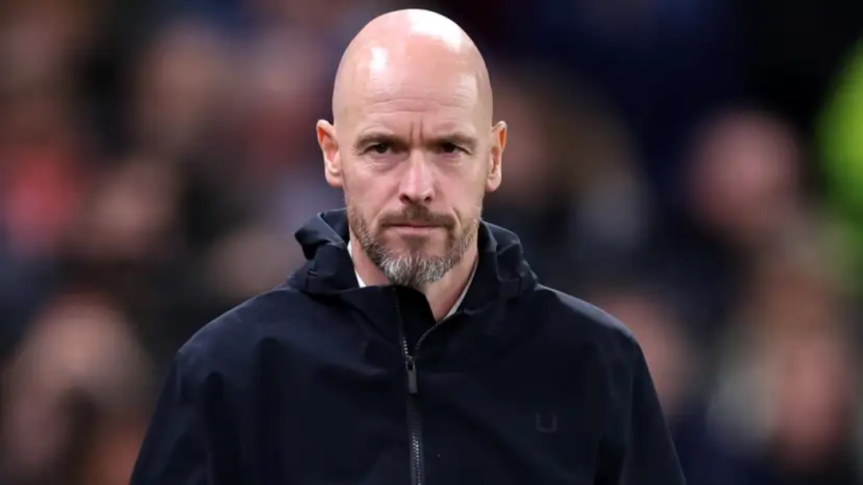Manchester United have started the second season under the Eric Ten Hag project imperfectly – in the opening rounds of the Premier League, the club forced two victories over mid-table sides, and lost to direct competitors in the fight for Champions League places. Fans were waiting for the situation to improve after the September national break, but the team continued to show not the most convincing performance, both in the Premier League and in the Champions League.
One of the main, but not the only, reasons for the lack of progress of Ten Hag’s football in the new season was an epidemic of injuries, which especially affected United’s defence. Already at the end of August, the club had to urgently enter the market in search of a left-back due to injuries to Tyrel Malacia and Luke Shaw. Sergio Reguilon was loaned from Tottenham Hotspur, but after three good matches, the Spaniard was also injured. The situation was further complicated by injuries of the main central defenders – Lisandro Martinez needed repeated surgery on his foot, Raphael Varane received his 9th injury during his stay in Manchester. Due to the lack of key players, Eric Ten Hag tried many combinations in defence, for example, he used Sofyan Amrabat and Viktor Lindelof as a left-back, and also revived the Maguire-Evans duo from the Leicester times.
The choices in attack were also limited, but for non-football reasons. In the match against Arsenal, Jadon Sancho did not on the squad, then publicly expressed disagreement with the decision of the head coach in social networks, and accused him of bias. The Englishman was suspended from training, he still has not apologized to his partners and manager, and continues to train separately from the main squad. Then Ten Hag lost Antony, who was accused of a sexual offense, during September the Brazilian was out of the training ground, but already managed to return to the squad, coming on as a substitute in the matches against Galatasaray and Brentford.
Due to the constant lack of players, United have lacked stability, without which it is impossible to make progress in the football of a Dutch specialist. The team was rushing from match to match, constantly changing the tactical plan, adjusting to the opponent. Nevertheless, even during this, shaky start to the season, United have had interesting ideas, and summer newcomers finally started playing. I propose to focus on these points in this text.
Match plots: 4-4-2 diamond against Brighton, aggressive start against Bayern, straightforwardness against Galatasaray
Ideas in pressure and without the ball
Immediately after the September break for international matches, United met at home with Brighton. Due to the lack of right wingers, Eric Ten Hag switched to a 4-4-2 diamond, which bore fruit at the start of the match – United aggressively pressed, limiting the opponent in the first 15-20 minutes, and making several possession transitions in the opponent’s half. But Brighton continued to insist on a short start of attack, and eventually found a weak point in United’s pressure.
In the build-up, Brighton habitually arranged the 2-2 build-up formation, plus, added the goalkeeper Steele. A pair of United strikers were pressing the pair of CBs, Bruno was taking care of one of the two central midfielders, the №8 closest to the ball was responsible for the second central midfielder.
The problem was the positions of the fullbacks, especially Veltman – Brighton carried out 46% of attacks through the right flank – who occupied the widest possible position, and leaving the United’s №8 in a 1v2 situation against the fullback and central midfielder. The fullback of United, in this case Reguilon, could not go higher in the pressure because of the fast Adingra, who constantly made runs behind Spaniard’s back, forcing him to stay in a deeper position. Christian Eriksen physically could not cope with the constant movements and fast one-twos of Veltman, Gross, and the rest of the Brighton players. Brighton easily passed the pressure and secured possession at the centre of the field.
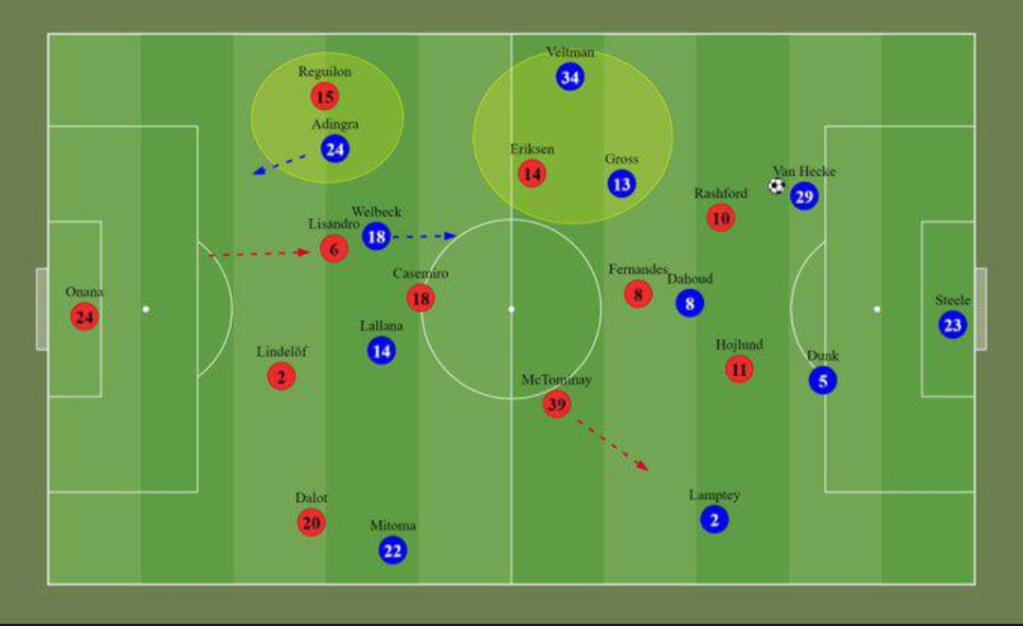
Against Bayern, the scenario of the match was repeated – aggressive pressure in the starting minutes, with successful attacking transitions from the opponent’s half, a rollback lower due to lack of strength for constant pressure, the opponent’s attacks through his right flank.
In the centre of the field, United created a situation of 3v3, or even 4v4. Fernandes played with Kimmich, Eriksen watched Goretzka, Casemiro took care of Musiala. Periodically, Kane dropped deeper, in such situations Martinez moved out of the line behind him. In the first line of pressure, Ten Hag’s team had a 3v4 situation, but thanks to aggressiveness and competent rearrangements – when Kim had the ball, Rashford was already shifting, and was guarding the pass to Upamecano – United managed to restrain Bayern in its third. By the middle of the half, the forces ran out, the Munich team squeezed the guests in their half with a long possession, and opened the score after Onana’s mistake.
As in the match against Brighton, most of United’s opponent’s attacks came through the right flank. Laimer regularly opened in a wide position, forcing Rashford to move more and get tired faster. The Austrian became the third in the number of touches in the Munich squad, only a couple of central defenders have more.
The match with Burnley was remembered for the radical rejection of possession – only for the fifth time under Ten Hag, United controlled the ball less than 40% of the time. Kompany’s team reached the central third without resistance, but could not convert possession into moments.
Ideas in possession
In the Premier League game with Palace, Ten Hag had a curious idea of passing the opponent’s mid-block through the left flank. Mason Mount regularly shifted from the middle as close to the left edge as possible, and put winger Andre Ayew in front of a difficult choice – either to control Mount and let Lindelof (Amrabat from the LB position went to the middle, the Swede used the width) to advance the ball without resistance, or to advance to the United defender and leave the Englishman free. Right-back Ward could not help his flank partner because of Rashford’s high position. After such a combination, United created their best open-play chance of the game – Hojlund’s chip in the 11th minute, according to the episode Rashford and Mount swapped places, but the pattern of movements remained.
Before the season, Ten Hag, in an interview, spoke about the desire to make “the best team in the world in transitional episodes,” and in the match with Galatasaray, this manifested itself to the maximum. The accuracy of United’s passes dropped to 72.9%, the worst result of the season, and one of the lowest during the Dutchman’s time at the club, while the number of passes and the percentage of possession were at the average level. The combination of these facts suggests the following: United were not forced to use complicated passes, the team itself consciously chose risky options, deliberately made it a «transition» game.
Players: Onana, LBs, Dalot, Rashford, Hojlund
Andre Onana
The Cameroonian is arguably United’s most criticized player at the moment, Onana got into an extremely difficult situation at the start of the season. Due to constant injuries in defence, and the lack of a well-established build-up structure, the Cameroonian cannot fully demonstrate his strengths when playing with the ball. Partners do not create enough options for their goalkeeper for a short pass, and he often ignores Casemiro. Under pressure, Onana is forced to use longballs, which led to the lowest accuracy of passes, and the share of short passes since the 17/18 season for the Cameroonian. With such a scenario of the beginning of the attack, United rarely succeeds in maintaining possession – aerial duels are not a strong quality of Hojlund, the Dane wins only 21.4%, one of the worst success rate amongst strikers in the Premier League.
The situation is also complicated by Onana’s game in goal, he has already made several goalkeeping mistakes. I am not strong in analysing this aspect of the game, I advise you to read the article by Matt Pizdrovsky from “The Athletic” about Onana’s actions on the line. Rumours have also leaked to the press that rival analysts are focusing the attention of their attackers on Onana’s positioning – in their opinion, after a mistake in the match with Lens, the Cameroonian often stays to close to the goal line. He does not shorten the distance with the opponent’s player, increasing the angle of fire, and reducing his chances of making a save. As the most striking example, Awoniyi’s goal is given after a United corner, when Onana froze in the 6’yrd box, and strangely fell on his back.
At the moment, Onana is deservedly criticized, but I consider the position “the goalkeeper must catch the ball, bring De Gea back” absolutely destructive. Onana did not have a chance to show his best qualities, a reasonable assessment of the correctness of the decision to buy the Cameroonian can be given only after a series of matches with the main defensive line, when the team will have the build-up structure.
Onana is psychologically strong – the Cameroonian took the blame after a mistake with Bayern, and, according to rumours, refused to go to the African Cup of Nations because of a bad start at United. An extra month with the team will help to build connections, and demonstrate to the fans that his purchase was the right step.
Left-back instability
In the last seven matches, United had three different players on the left in defence. Sergio Reguilon has played three times since the beginning of September, having been injured at the end of the game with Burnley. Sofyan Amrabat played the next three matches, and in the last meeting with Brentford, Victor Lindelof came out on the left in defence from the first minutes. Due to the different main foot, the tasks of the Reguilon were radically different from what was required of the Moroccan and the Swede. However, all three were useful, just in different ways.
Reguilon is a classic overlap defender, his strengths are joining the attack wide on the flank, and crosses into the penalty area. The Spaniard practically does not go into the half flank, which is clearly visible on his map of touches in the Premier League. According to his career, Reguilon makes 3-3.5 crosses per match, this is not the level of TAA or Trippier, but still a high indicator. The Spaniard demonstrated an excellent attacking performance in the match with Bayern – he constantly opened wide, dragged the ball into dangerous areas on the dribble, became second in the team in the number of crosses, third in the number of touches in the final third. Visually, Reguilon immediately had a great connection with Rashford.




Obviously, buying the Spaniard from Tottenham is pointless. The team already has Shaw and Malacia, whose simultaneous absence is an anomaly, plus Fernandez will return from loan in Granada. Nevertheless, Reguilon performed well in the matches he played, and after the match with Bayern even received a praise from Ten Hag on MUTV.
Using the right-footed Amrabat in a wide position would be ineffective, so the Moroccan regularly shifted closer to the middle, giving the flank to Rashford/Garnacho. Due to the unsystematic build-up, the Moroccan could be in any position: stay on the same line with a pair of CBs; rise higher at the moments when Casemiro dropped between CBs; form a 3-2 build-up with the Brazilian. On the ball, Amrabat is not impressive yet – he was one of the most involved in the possession of Fiorentina players last season (second in possession in Serie A), but quantity is not equal to quality. Amrabat passes a lot to close players, periodically does not see good options between the lines, sometimes makes fuzzy, crushing passes.
Amrabat made a much greater impression without the ball. His defensive numbers for last season are low – again, the impact of playing in a team with a large percentage of possession (the more possession, the less chance to engage in martial arts in defence), but the reading of the episode is developed at a high level. When losing the ball, Amrabat regularly found himself in the rebound zone, instantly putting pressure on the opponent’s player. Such episodes often ended with a quick return of possession in a high position, United’s attack resumed.


Lindelof played on the left of the defence only the second half with Palace in the cup, and the game with Brentford in the Premier League. He did not go for rebound as actively as Amrabat, and did not give the same number of overlaps on the flank as Reguilon. In my opinion, the strength of the Swede when used in this position is the understanding of space. Lindelof plays longer under the guidance of Ten Hag, and feels better the moment when you need to take the width / climb into the CDM’s zone / step into opponent’s third. The scoring attack on the third goal in the cup meeting with Palace began with a smart opening of the Swede, who broke the opponent’s pressure.
Diogo Dalot: attacking influence
Due to the lack of right wingers, the roll to the right flank observed at the beginning of the season has ceased to be relevant, in the Premier League, United conducts 37% of attacks on each of the flanks. Despite the decrease in activity from the right side, it is impossible not to note the game of Diogo Dalot. The Portuguese is one of the most stable players of the club this season, only Bruno and Casemiro have played more than him out of field players.
Against a low block, United often used the idea of concentrating players on the left flank, and making a switch to Dalot. The Portuguese has become braver in 1v1 situations, he often goes into dribble, and after a successful one, either makes low-cross at the near post or makes a cutback. When the attack is on the right flank, Dalot actively uses the width, constantly making overlaps.



The big plus of the Portuguese is his versatility, both within one position and placing him on the field. In the right-back position, Dalot is not limited to playing only on the flank, he often shifts to the centre, and makes underlaps, which I wrote about in the text at the end of the summer. At the same time, if necessary, he can also go out on the left flank, which he regularly does in recent matches for the national team.
The aspect in which I want Dalot to progress more is his decisions in the final third, influence on the creation of shot-situations. Over the past year, the Portuguese has only the 58th percentile in terms of pre-shot actions, and a nightmarish 30th percentile in xA/90 among the fullbacks of the top 5 leagues. For comparison, Luke Shaw is in the top 30% on both indicators.
Marcus Rashford: catastrophic decisions, but the underlying numbers are…
In addition to Onana, Marcus Rashford is under serious pressure in the media. The main reason for the criticism of the Englishman is his actions in the final stage – Rashford unacceptably often makes catastrophic decisions in the final phase. The United winger overstays the ball when it is necessary to shoot with one touch, and often bumps into the front line, takes over the game, having open partners in a more advantageous position, chooses unfavourable positions for shots. The most striking example of Marcus’ selfish decisions was the game against Brighton, when Rashford made 9 shots (the other players registered only 5 shots combined), but the total xG of the Englishman’s attempts was only 0.56, and more than half of the shots were blocked. Only Holland shoots more often in the Premier League, but since the 17/18 season, the Englishman has the lowest average strike weight, only 0.09 xG/shot.
At the same time, Rashford has an excellent spell in terms of delivering the ball into dangerous areas. He is 4th in the EPL in the overall xThreat, and tops the table in the xThreat created through carries. Personally, this is his best season so far in passes to the penalty area, and the number of carries that ended in the opponent’s penalty area, which is 3.37 per match. For comparison, the best by this metric in the last season of the Premier League was Kaoru Mitoma, with an indicator of 3.29 (filter 2000 minutes played).
When playing without the ball, Rashford remains the main threat of the team in offensive transitions, partners always try to find him with a pass after a successive tackle or interception. Due to poor decisions in such situations, United sit only 14th in the Premier League in xG from counters/90. Also, Rashford is the weak point of the team when pressing and positional defence. This fact is very eloquently confirmed by the statistics of the direction of attacks of United’s opponents in matches where the Englishman came out at the start – 47% of attacks pass through their right flank, the Rashford zone. The United left winger is more inert than his attacking partners in active defence, he often turns off, freezes in place. When defending in his own half, Rashford often loses his player due to rare head turns, and when marking the player, he can afford to switch off in the middle of an episode.

The main thing that Rashford lacks at the start of the season is the killer instinct in front of opponent’s goal. The Englishman definitely has it, he demonstrated it very vividly right after the World Cup. Perhaps 1-2 matches in reserve will benefit. Garnacho successfully comes on as a substitute, United will not critically sink in quality, and such a pause will show Rashford that his place at the start is not guaranteed, will allow him to reboot.
Rasmus Hojlund
If you’d ask me to describe the new striker of United in one word, “movement” is best suited, he definitely cannot be called a lazy, passive player. Hojlund is not too comfortable playing against teams defending with a low block (although, against Brentford, he successfully opened between the lines several times), he shows his best qualities in space. For example, the Dane just loves to make runs into the corridor between the fullback and the central defender. Over the past 365 days, on average, Hojlund receives more than 10 progressive passes per match, only 2% of forwards from the top 5 leagues receive more.

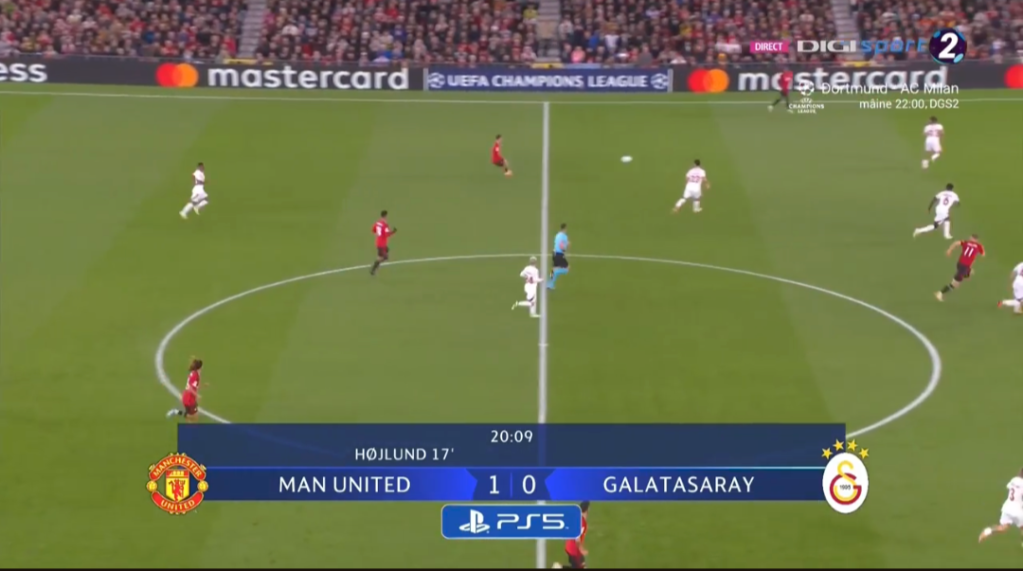
If necessary, the United striker can create a moment for himself in space. He feels confident with the ball in his legs, often delivering it to the penalty area by carries, and is not afraid to dribble – more than 3 attempts per match. Hojlund’s first touch is fickle, he can beautifully get away from the defender hanging on his back with one move, and in the next episode he can clumsily lose the ball after a simple pass.
While receiving with his back to the goal, the Dane either puts one hand back, or spreads his shoulders wide, and makes it as difficult as possible for the opponent to get to the ball. Pulling the defender on himself, he creates space for partners, which is especially useful when switching to the attack.


Without the ball, Hojlund takes an active part in the team’s game. He is concentrated, does not get lost when pressing from the starting positions, and immediately begins to pressure after the loss. The Dane rarely tackles, but with his movements he puts regular pressure on the opposing players, reducing their decision-making time. Hojlund’s moves correctly without the ball – instead of straight lines, he chooses bended trajectories, blocking more options for a pass.
Of the disadvantages of the Dane, you can note his aerials. Hojlund wins only 21.4% of them, with vertical passes from Onana or defenders, he chooses the moment to jump badly, often does not even jump at all. If he still gets to the ball, then he does not play well with his head, which affects both the quality of drops and the strength of his headers after crosses. Visually, with the arrival of Hojlund, United uses low/medium height crosses and cutbacks more often, and in situations with high crosses, Casemiro is regularly runs into the penalty area.
4 Points worth paying attention to in United’s Next Matches
1. Build-up: Shaw and Varane should recover for the game with Sheffield – how will their return affect the team’s build-up? Will Onana show his best qualities in the passing game?
2. Transitions after high pressure: United leads the league in the number of high turnovers, but so far has never scored after such situations. When?
3. Casemiro’s runs into the penalty area: for the entire last season, the Brazilian reached the ball 24 times in the centre of the penalty area, in October he already has 17 touches in this zone. Will he continue to support the attack this way? Are such runs useful in terms of risk-reward?
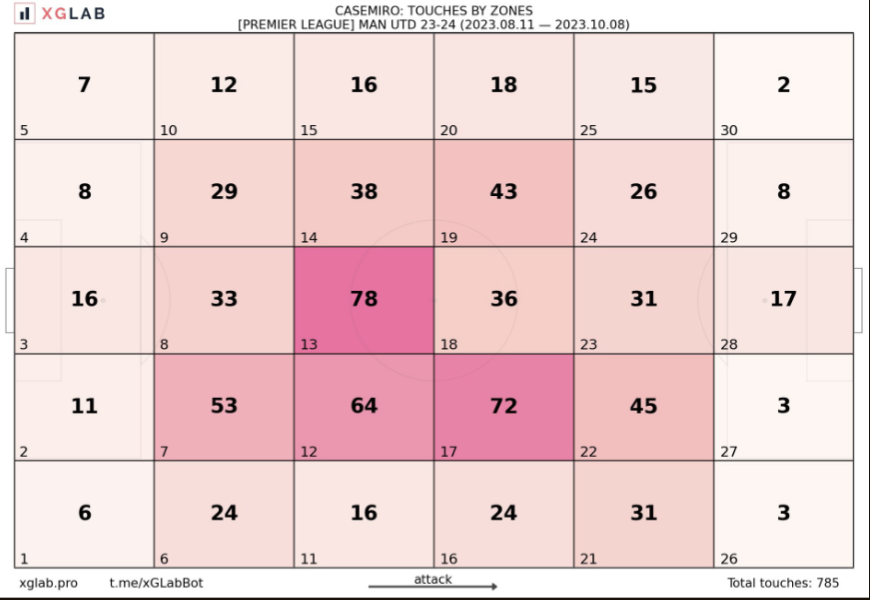
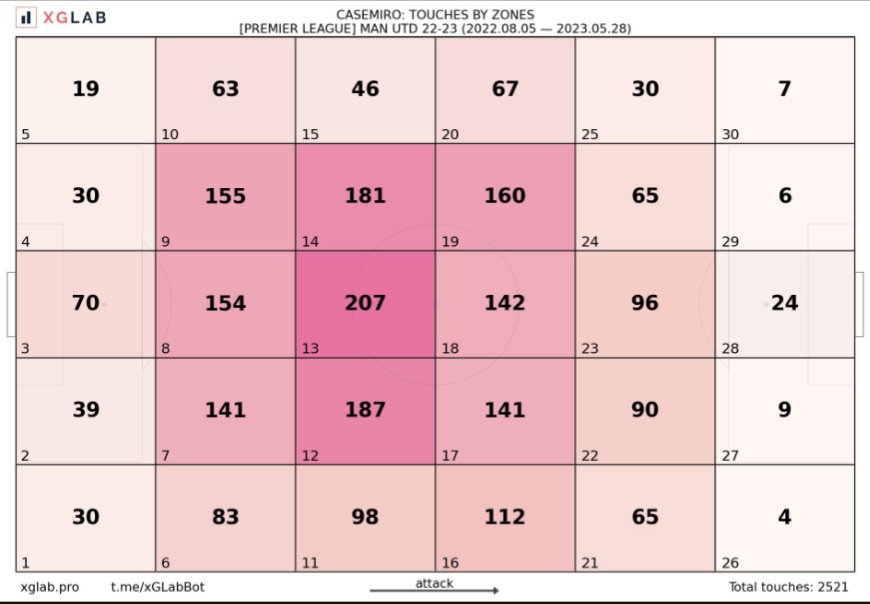
4. Mason Mount: the Englishman still does not have a clear position, he has already appeared in a pair of CMs and an attacking midfielder in 4-2-3-1, the left №8 in 4-3-3. Will Mount have a specific role? Where are his skills revealed in the best way?
Results of the beginning of autumn for United
At the moment, the team is performing poorly, the 10th place in the Premier League and the last in the Champions League group is not the level of Manchester United. Nevertheless, the impact of the injury factor was too great – for the entire autumn period, Ten Hag was forced to build a game without three main defensive players, and solve the problem of replacing the right winger. In addition to the games with City in the championship and Newcastle in the League Cup, before the next international break, United are waiting for 3 matches with the outsiders of the Premier League, and two against Copenhagen in the UCL. The main task of the team in this period is to integrate the newly returned defensive players, to gain several confident victories, not only on the scoresheet, but also in the quality of the game. In Ten Hag I trust.
This guest piece was written by @normalnik131. Be sure to follow them on Twitter!
